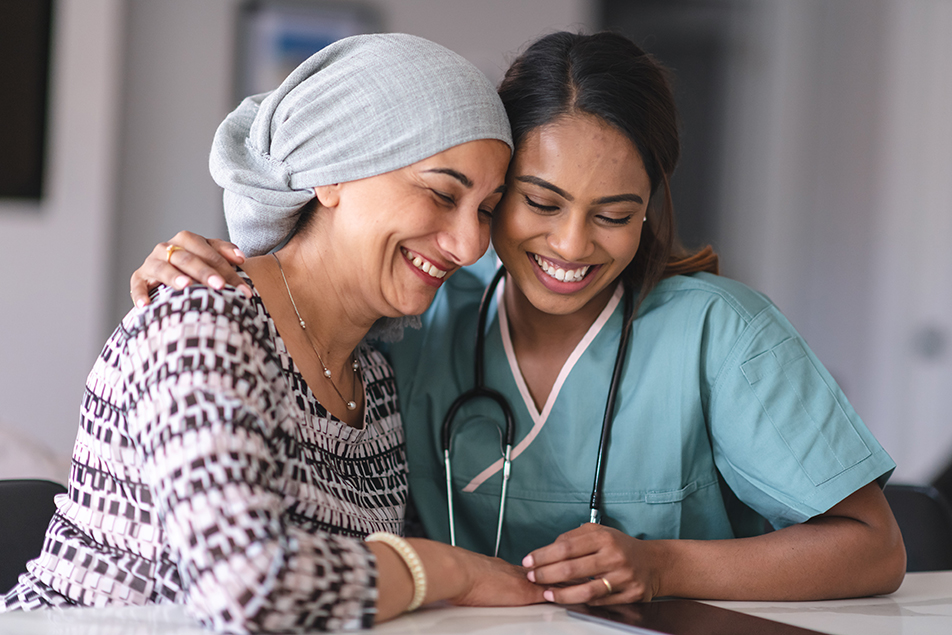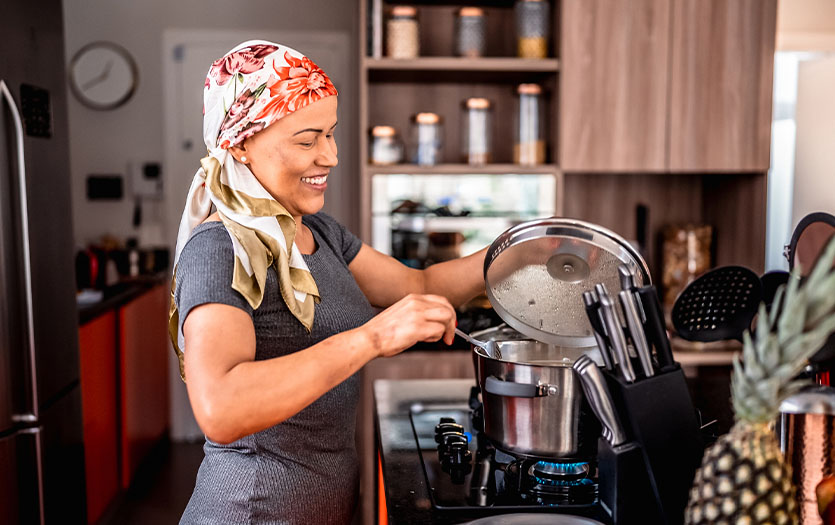
A cancer diagnosis and treatment is overwhelming, but Palliative Oncology helps relieve a patient’s symptoms and improves their quality of life. It can be used at any stage of illness to help address the physical, emotional, logistical and even spiritual concerns of patients, caregivers and family members. To better understand this holistic approach to care, we asked Joseph McCollum, DO, Palliative Care Team, Parkview Cancer Institute, to answer a few questions about his work as a palliative oncologist and the many benefits it brings to patients as they navigate cancer.
What is a palliative oncologist?
The word palliate means “to cloak.” Think of someone standing out in the rain. My job as a palliative oncologist is similar to taking a jacket off, wrapping it around them and providing that extra layer of comfort. We see patients of all ages and stages of their cancer. Anytime a patient experiences symptoms associated with their cancer or treatment, we can offer assistance and support for their pain, nausea, appetite or difficulty sleeping.
Additionally, we have added support to offer patients going through psychological or social distress like anxiety, depression or post-traumatic stress disorder. We also have spiritual advisors on our team to support spiritual and existential despair. Palliative Oncology is a holistic specialty that wraps around patients during one of the most challenging times in their lives.
What is the difference between palliative and hospice care?
Hospice care is specifically for patients who have a terminal illness. Terminal cancer is that which will likely lead to the end of their life over the next six months. Palliative care, however, is a symptom and support management service, which helps patients at all ages and stages of their disease. As a palliative oncologist, I see some patients with a very early stage of cancer, experiencing some symptoms and distress, but I help them straight through to survivorship. Then, I have other patients diagnosed with stage four but can still have an excellent quality of life.
Metastatic breast cancer is a great example. We have a lot of metastatic breast cancer thrivers who are going through treatment and doing exceptionally well. As a palliative oncologist, I can follow them through their treatment. If their cancer progresses, I can create a seamless shift over to my hospice colleagues who can deliver care in an inpatient setting or the patient’s home. Palliative care and palliative oncology are there at diagnosis, helping patients throughout any treatment, regardless of where they are going on their journey.
What is the scope of a palliative oncologist’s role?
Palliative oncologists go through extra training to understand the disease, drugs and symptoms associated with a patient’s diagnosis. We spend extra time alongside the other members of the patient’s care team, coordinating care and ensuring everyone's in contact with one another, ensuring the patient's voice is elevated in those conversations and their questions and concerns are being addressed. We also try to reach out to family members and caregivers in partnership with the patient, helping them understand and anticipate what's to come.
Furthermore, Palliative Oncology fits well with survivorship care, too, as we take pride in supporting and celebrating these patients and bringing them from a cancer survivor to a cancer thriver. We're looking at what's in front as well as the full spectrum and quality of life.
Do palliative oncologists see patients throughout their treatment?
Yes, we see them frequently, especially patients who have high levels of distress. We help provide extra comfort and support as they progress through their treatment plan. If a patient is experiencing fewer symptoms and less pain, we will see them less frequently. And more often than not, we can coincide with the rest of their appointments, so they do not have to schedule more than necessary.
How do palliative oncologists help patients with their fears, anxieties and pain?
A great deal of what we deal with can be medical-based treatments, and we're fully licensed to manage those therapies. Still, when patients are on active chemotherapy, many are already overwhelmed with the medications they must manage. So, being able to bring in nonpharmacological strategies to empower patients is very important. Counseling and cognitive behavioral therapy are integral parts of unpacking the emotions and distress they're feeling.
We also strive to equip and empower both patients and their caregivers, so everyone can feel prepared and know what to anticipate. A lot of our fears come from the unknown. So, when we have somebody charting the course for us, serving as a guide and resource provides reassurance. Some medical research suggests that cancer patients’ reported pain levels went down without a single drug by merely having a palliative oncologist enter the visit. The presence and connection with an expert were enough to control their pain.
What can patients and their families do to keep their anxieties and fear at bay?
The first step is identifying a support person or community, somebody in your life that will connect with you. You need an extra set of eyes and ears in every appointment, someone who's going to be able to write things down and track the information as it comes. The hardest appointments are for people who are alone in their journey. The truth is, when I'm talking to patients, they may only be absorbing 10% of what I'm saying, so having that companion or caregiver to help process and ask the right questions is invaluable. It goes a long way to alleviate a patient’s anxiety and stress as they begin their journey.
How do you help patients work through the emotional and body-altering side effects of the disease?
Recognizing that some treatments have consequences, some reversible while others are not, is the first step. Meeting patients in that moment and providing additional resources is crucial. I've had many patients who didn't want to lose a piece of themselves, which prevented them from pursuing treatment. As a palliative oncologist, it's important for me to connect with patients, find out the unique beauty in them, and awaken that in our appointments together. Additional supportive services are also vital in helping patients. For those who’ve lost their hair, a wig or fun, funky headdress could be just what they needed to feel whole again, to regain their identity and feel empowered.
Do you encourage your patients to find strength in faith?
Because palliative oncology strives for a holistic approach to patient care, we welcome chaplaincy into the fold of our multidisciplinary group of experts to help surround cancer patients in support. We’ve found that being able to screen for spiritual and existential distress and provide a spiritual guide to patients can help them navigate treatments, allowing them to have a spirit of wellness and wholeness on the other side.
Have virtual care options helped you treat patients during their cancer journey?
Amid the challenges we are all facing during this pandemic, I think many physicians nationwide have been trying to use virtual care to reach patients, especially in rural communities. Initially, many of my patients were intimidated by the technology, especially older patients who didn't grow up using video conferencing on a smartphone or laptop. Fortunately, we've partnered with a lot of family members, spouses, children and grandchildren to be able to reach out.
Amazingly, the feedback we've gotten has been overwhelmingly positive. Once patients try it, they've said they enjoyed the connection, and I think it can be lifesaving for specific individuals. We see certain things with our eyes that we wouldn't be able to hear over the phone in patients who either are too sick or too scared because of COVID-19 to be able to come to the clinic.
What advice would you give to patients as they embark on their cancer journey?
I like to tell all my patients that ultimately, they are my boss. This is their journey. They're the captain of the ship, and I am the guide. I've sailed the seas many times, but they still decide the destination. I help prepare them for their journey and see them through it. Many different factors go into what therapy fits which individual, and part of figuring out that pairing is looking at a patient's medical conditions going into a cancer diagnosis. I like to say everything is a risk-benefit scenario. My job is to make sure patients understand each intervention's risks, the benefits of that intervention, and the alternative to it. It's a shared decision that we make together, knowing that none of us has a crystal ball. We don't know what will work and what won't work, but together we're going to find a strategy that fits you.



